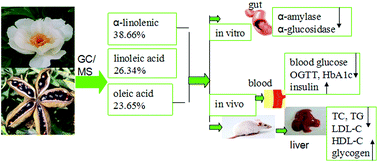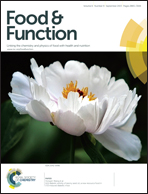Anti-diabetic activity of peony seed oil, a new resource food in STZ-induced diabetic mice
Abstract
This study was conducted to investigate the components of a new resource food in China, peony seed oil (PSO) by GC-MS (gas chromatography–mass spectrometry), its inhibitory effects on carbohydrate hydrolyzing enzymes in vitro and its anti-diabetic effects on mice induced by streptozotocin (STZ). The results showed that peony seed oil showed weak anti-α-amylase activity; however, strong anti-α-glucosidase activity was noted. The GC-MS analysis of the oil showed 9 constituents of which α-linolenic acid was found to be the major component (38.66%), followed by linoleic acid (26.34%) and oleic acid (23.65%). The anti-diabetic potential of peony seed oil was tested in STZ induced diabetic mice. Administration of peony seed oil and glibenclamide reduced the blood glucose level and the area under curve (AUC) in STZ induced diabetic mice. There were significant increases in body weight, liver glycogen content, serum insulin level, high-density lipoprotein cholesterol (HDL-C) and decreases in glycosylated hemoglobin (HbA1C), total serum cholesterol (TC), and triglyceride (TG) in test groups as compared to the untreated diabetic groups. In vivo antioxidant studies on STZ induced diabetic mice revealed the reduction of malondialdehyde (MDA) and increase of glutathione peroxides (GSH-px), superoxide dismutase (SOD), and glutathione (GSH). The results provided a sound rationale for future clinical trials of oral administration of peony seed oil to alleviate postprandial hyperglycemia in streptozotocin-induced diabetic mice.


 Please wait while we load your content...
Please wait while we load your content...